by Winding Pathways | Sep 13, 2018 | Nature, Travel/Columns
Why I Wanted to Visit Alaska In the Winter
Guest Blogger, Jane Suiter
Potos by Jane Suiter
I have the privilege of having two friends who call Alaska home. My first visit was in the summer of 1998 when I turned 50. Because I had always wanted to visit Alaska, I went that year. My second trip was the summer of 2017. The summer solstice to be specific since it was my birthday. I wanted to experience close to 24 hours of sunshine. It made it much easier to get up in the middle of the night for a bathroom trip. I didn’t have to turn on the light.
My most recent visit followed close on the heels of the summer visit – Thanksgiving 2017. While my main reason for the visit was to see my friends, I had some other reasons to visit this time of year. I wanted to experience the Northern Lights, the late sunrise and early sunsets, and an earthquake.
Appeal of the Aurora
Of course, the Northern Lights, or Aurora Borealis, occur all times of the year but the summer night sky isn’t dark enough for the lights to be visible to onlookers.

Aurora. Photo by Jane Suiter
I arrived on a Sunday. My friend, Brenda, is a teacher and had to work Monday and Tuesday of Thanksgiving week. She has an app that tracks the possibility of Northern Lights occurring in the Eagle River, AK, area. Her bedroom was upstairs and mine was on the main level. At 11 p.m. the first night she texted me to see if I was still awake. I don’t usually go to bed before midnight so I was. She asked if I wanted to go check out the Northern Lights. I knew she had to work the next day and I was impressed that she was willing to go check them out.
We drove up Mount Baldy so we would have an unobstructed view of the sky. When we got to the top we weren’t the only ones there. Other people had gathered to see the lights. Fortunately, we found a parking place in the crowded lot. We were not disappointed. The Aurora Borealis was spectacular. The light show lasted about 15 minutes. Most of the color was green but every once in a while, we were treated to some other colors. A continuous wave of light danced across the sky. It was amazing and something I won’t forget.
Experiencing the Dark
My second reason to visit in winter occurred every day. I wanted to experience the short days of winter in the north. Sunrise was around 9:15 a.m. and sunset was around 4 p.m. I didn’t have a problem with the 4 p.m. sunset but didn’t like the 9:15 a.m. sunrise. I would like to go to work in the sunlight and don’t mind coming home in the dark. This span of sunshine time would bother me if I lived there.
Feeling the Earth Move Under My Feet
My third reason to re-visit Alaska happened on the day I was scheduled to leave. I have traveled to California several times and have never felt an earthquake. As a retired earth science teacher, I wanted to experience an earthquake without damage or fear for my life.
The day it happened in Alaska, I was sitting at the table and all of a sudden everything started shaking. It was an earthquake! The epicenter was about 100 miles away and it was a 5.1 on the Richter scale. The shaking lasted about 10 seconds and some of the items on the bookshelves were vibrating. It was an interesting sensation, to say the least.
Spectacular Views
For anyone visiting Alaska one of the sites to see is Denali, the mountain. It is a rare opportunity to see this mountain. In June we could see it from afar on our way back to Anchorage. I took a bus tour into the park but it was a cloudy and rainy day so no mountain view. We took a train from Anchorage to Talkeetna to spend the night. On the way to Talkeetna, Denali was visible. The train even stopped so we could take pictures. When we got to Talkeetna, we walked around this small town. We found a spot along the river where Denali was still visible. It was a great site.
I loved my winter trip to Alaska and I think you will, too.
-
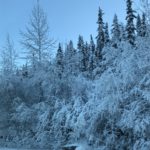
-
Frost covered trees.
-

-
Jane with friends on the train.
-

-
Making pies!
-

-
“The Great One” from the indigenous Koyukon language.
by Marion Patterson | Sep 7, 2018 | Bugs, Nature, Wonderment
Guest Blogger, Sheryl Ochs
On a jaunt to the garden to retrieve some herbs for my freshly cooked carrots, I paused in surprise to see 12 small black caterpillars, each with a tiny white stripe in the middle, chomping away on my only parsley plant.
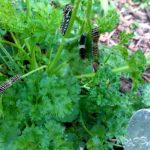
Caterpillars happily munch parsley leaves.
I knew that parsley was a butterfly host plant, and I knew that Swallowtail butterflies were partial to it, but the only ones I’d noticed before were bigger, fatter and striped with yellow/green.
Seeking advice from a trusted website, I discovered the tiny black caterpillars were indeed the first instars of the caterpillars on their way to becoming Swallowtail butterflies. As I watched what I called “my children” grow, I saw each of the four instar stages in which they shed their skin.
Each morning and evening I’d head to the garden to make certain they had not succumbed to hungry birds or other predators and each time I was relieved to count 12.
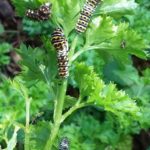
Caterpillars on parsley.
Before the caterpillars finally vacated, they mostly decimated my parsley leaving only a small sprig for my next dish of carrots. A small price to pay for the pleasure of watching them grow to adulthood. Now they’ve meandered off to form their chrysalises and I anxiously await an influx of beautiful butterflies to grace my yard.
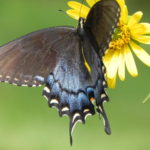
Black Swallowtail butterfly on cup plant.
by Winding Pathways | Aug 9, 2018 | Birds, Nature
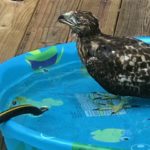
Young hawk cooling off.
On May 31st just before we were leaving for an Outdoor Writers Association of America Conference, a friend messaged pictures to me of a large bird in her little dog wading pool. It looked like a hawk of some sort. The day was super hot for late May and the bird seemed distressed. Soon it wandered off.
Rich and I drove to our friend’s home and looked around, finding the bird burrowed into the cool, wet soil shaking its head as gnats and flies tormented it. I emailed Dave Coates who has worked with eagle counting and asked if he had contacts for someone to rescue the bird. He suggested the Mcbride Raptor Center that I knew had closed.
Then, Rich reminded me of Phil who works with raptors at the RARE group. (Raptor Advocacy, Rehabilitation, and Education is now the contact group).
I buzzed True Value on Mt. Vernon Rd. and the staff kindly put me in touch with Phil.
That is where our involvement stopped. And, I had wondered several times since the outcome.
-
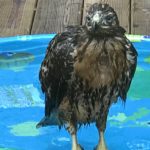
-
On edge of pool
-
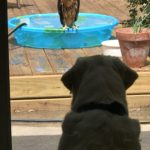
-
Sizing each other up.
-
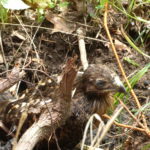
-
Hawk being tormented by gnats and flies.
Dave emailed me in mid-June because he had also wondered about the outcome. His email spurred me to follow up. Here is Nancy’s reply.
“The red-tailed hawk was taken to the RARE center by Phil where they fed her, gave her fluids and made sure she was healthy, then returned her to a tree in our yard. They thought the parents would find her and help her until her flying feathers were more mature. She stayed for about 24 hours but then she was gone. We’re hoping she reunited with a Mom hawk. Actually, I keep thinking I’ll see her in the wading pool again someday.”
So, all is well that ends well. This is the second raptor rescue of the season we have been involved in. Many thanks to folks who care enough to follow through.
by Winding Pathways | Aug 2, 2018 | Garden/Yard, Nature, Pests
Mugging Barberry
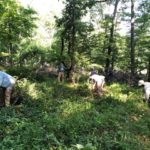
It’s a tough task eradicating Barberry.
One pleasant Saturday morning a couple dozen heavily armed people walked to the interior of Faulkes Heritage Woods. Their weapons were those used to help heal the forest and included thick leather gloves, lopping shears, hand saws, and clippers. They were out to defeat Japanese Barberry.
For two hours they attacked a huge patch of Japanese Barberry that had infiltrated the Woods. Grasping small ones with both hands people yanked them from the soil, shook them off and placed them so the roots would dry out and not re-root. In winter, when the Barberry has berries, the plants are placed on tarps and hauled off so the berries do not drop and root. Ones too big to pull were cut off at ground level.
Volunteers were organized by the Iowa Natural Heritage Foundation. It holds a conservation easement on the property that’s owned by the Marion City Parks Department. Park staff helped, and so did a crew of young people enrolled in AmeriCorps. Various local volunteers pulled and cut.
In Its Native Habitat, It is OK.
Just why is Japanese Barberry such an onerous plant? Actually, it’s a fine shrub in Japan and other parts of Asia where it’s native. There it has natural forces that keep its density in check. It was brought to North America as a landscaping plant because barberry is easy to propagate and transplant. It thrives in many locations, including compacted soil of building sites. It is an ideal landscape plant with one terrible trait.
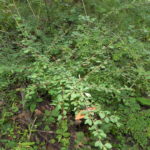
Barberry creates impenetrable tangles and changes the soil chemistry.
The plant produces red fruits in late summer that birds find delicious. They gobble them up, fly away, and poop the seeds out. So, birds snacked on barberries planted in yards and delivered the seeds into Faulkes Woods, where the seeds grow with gusto into impenetrable “pukka brush”.
Barberries crowd out native wildflowers and do much more damage. They actually change the soil chemistry to their advantage while making it less suitable for native plants. And, the dense shrubs create pockets of humidity. Each becomes an oasis of comfort for ticks.
Preserving and Exploring Faulkes Heritage Woods
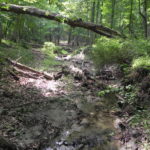
Many hollows and ravines characterize Faulkes Heritage Woods.
Faulkes Heritage Woods is a gorgeous 110-acre steep forest adjoining Winding Pathways. We walk there often. Huge oaks and other native trees fill its wondrous spaces. Wildflowers abound, especially in the spring, and birding is excellent for woodland species. Pileated woodpeckers are common.
A looping footpath starts and ends at a trailhead off Tama Street Southeast. Visitors can park along the street and enjoy the woods. But, they don’t have to stick to the trail that only covers a small area. Walkers are welcome to go off trail and scramble through the woods to enjoy its beauty and solitude.
For information:
Marion Parks and Recreation: (319)447-3580
Iowa Natural Heritage Foundation: (515)288-1846
Winding Pathways LLC.
by Winding Pathways | Jul 26, 2018 | (Sub)Urban Homesteading, Birds, Bugs, Flowers/Grasses, Garden/Yard, Nature, Reflections/Profiles, Wonderment
The Gazette in Cedar Rapids has had several interesting nature stories connected to creating wondrous yards. Living Section features “Birds do it, Bees do it”, “Add a Little Luck to Your Landscape” and Purslane (by Winding Pathways). We loved reading about the birds and bees’ cooling strategies and welcomed the return of clover to yards as natural nitrogen fixers and deep-rooted water retention plants. And, of course, we love to eat purslane. Let us know ways you fix this healthy vegetable.
Also an article on wasps of late summer. They are beneficial, ‘though deserve keeping distance.
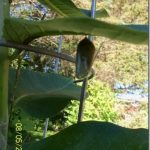
Success on the Bena Farm!
Best of all was the picture of the Monarch Chrysalis from friends, Nancy and Gordon Bena found on their farm. Let’s keep encouraging habitat for insects that form the basis of life for many other creatures.
by Winding Pathways | Jul 19, 2018 | (Sub)Urban Homesteading, Amphibians/Reptiles, Birds, Garden/Yard, Mammals, Nature
Susan Hrobar
guest blogger
Fun Through the Window
We are fortunate to live at the end of a channel on a small lake. Our north facing windows face our backyard and the channel. One of our friends, who knows very little about nature, does not understand that after living here for 18 years, we still get excited when we see any wildlife in our yard and in the channel. Most of my photos are taken from windows inside the house, hoping to not spook my photo subjects. We frequently have deer coming through and we can tell which paths are being worn into the ground. During the winter we’ve taken photos of deer amidst the falling snowflakes. And, on our trail cam, we have “caught” coyotes, fox, raccoons, opossums, and neighborhood kitties.
Tom Turkey
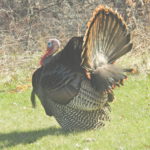
Strutting
This spring we have had a special bonus of occasionally watching a male turkey strut between our and the neighbors’ yards. Usually, he is skittish and if he spots me looking out a window, he quickly moves out of sight. One morning he must have felt like he was “king of the hill” and actually posed for photos about 20 feet from where I was watching him. I have also watched him fly over the channel near dusk and find a tree to roost in for the night. It always amazes me to watch these big birds fly through the trees, as normally you only see them walking and running on the ground.
Turtle Habitat
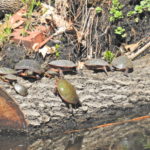
Lounging on a log
Last summer when the water level was high, an oak tree uprooted and fell into the channel, covering both sides of the channel, and completely blocking our water access to the main lake. Because the channel is narrow, there is little clear land on either side. The oak landed at the bottom of a steep hill, so removing it was quite a process. It took a bucket truck on top of the hill, a small boat in the channel, lots of ropes, and a very talented arborist to take care of the problem. This spring the water is lower and that downed tree is now a horizontal stump about four feet long partially submerged from where it fell.
The turtles love this new sunning perch! We have never seen so many turtles at one time. So far, our biggest count has been nine painted turtles on the log. In spring we sometimes get lucky to see a large soft-shell turtle swimming in the channel and climbing out onto the shore. The females are much larger than the males.
Wood Duck- Goose Dustoff
On a recent rainy day, we spotted a pair of wood ducks. They are also very skittish and do not like to pose for photos. We watched as they flew up into a large basswood tree and perched on the branch. I think that is the first time I have ever seen ducks sitting in the trees. It was not a great day for photos, but I tried anyway.
The ducks flew to another tree, rested for a while, and then flew down to the water. Mr. Wood Duck and Mr. (Canada) Goose then had an altercation on the grass with much hissing, honking, flapping of wings, and chasing.
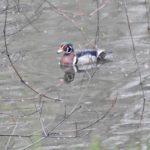
Male wood duck
Mr. Wood Duck was very proud of himself for chasing the goose parents and two goslings of out “his” channel. Mrs. Wood Duck cheered him on while sitting on top of our boat motor. My husband, John, had the fun of watching the goose and duck stand-off. I was trying to get to a different window without all the raindrops obscuring my view. That did not work, but it made me smile to hear John laughing and enjoying the whole spectacle.
Loving Our Wildlife
Even after nearly two decades, we still so enjoy our yard and sharing our stories about animals and plants.
-
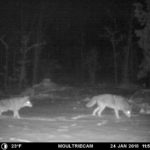
-
Night activity
-
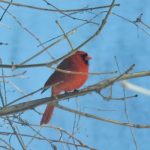
-
Male Cardinal in a tree.
-
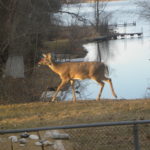
-
Deer in yard.
-
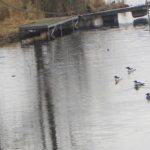
-
Swimming
-
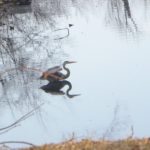
-
A heron spreads its wings
-
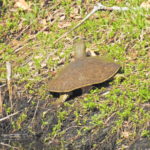
-
Female soft shells are larger than the male.

























